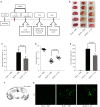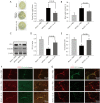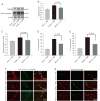Interleukin-35 attenuates blood-brain barrier dysfunction caused by cerebral ischemia-reperfusion injury through inhibiting brain endothelial cell injury
- PMID: 35965799
- PMCID: PMC9372693
- DOI: 10.21037/atm-22-2770
Interleukin-35 attenuates blood-brain barrier dysfunction caused by cerebral ischemia-reperfusion injury through inhibiting brain endothelial cell injury
Abstract
Background: Interleukin-35 (IL-35), an anti-inflammatory and antioxidant cytokine, plays a potent immunosuppressive role in various diseases. However, the effects of IL-35 on blood-brain barrier (BBB) dysfunction in ischemic stroke are not well characterized.
Methods: A total of 150 male C57BL/6 mice (aged 6-8 weeks and weighing 20-25 g) were used in this study. The protective effects of IL-35 against BBB dysfunction were examined using a mouse model of middle cerebral artery occlusion (MCAO) and an in vitro model of oxygen-glucose deprivation/reoxygenation (OGD/R) injury in mouse brain endothelial cells (bEnd.3).
Results: Intracerebroventricular administration of IL-35 (10 µg/g) was found to reduce cerebral edema and Evans blue (EB) leakage, and increase the expression of tight junction (TJ) proteins, thereby attenuating MCAO-induced neurological deficit in mice. Moreover, IL-35 (20 ng/mL) treatment upregulated the expression of TJ proteins in OGD/R-induced bEnd.3 cells. IL-35 also markedly suppressed the expression of caspase-1, IL-1β, and gasdermin D (GSDMD) in vivo and in vitro. In addition, IL-35 decreased the generation of reactive oxygen species (ROS) and inhibited the expression of thioredoxin-interacting protein (TXNIP) in OGD/R-induced bEnd.3 cells.
Conclusions: These results indicated that IL-35 exerts a protective effect on the BBB by targeting the ROS/TXNIP/caspase-1 pathway in cerebral ischemia-reperfusion (I/R) injury.
Keywords: Ischemic stroke; blood-brain barrier (BBB); caspase-1; interleukin-35 (IL-35).
2022 Annals of Translational Medicine. All rights reserved.
Conflict of interest statement
Conflicts of Interest: All authors have completed the ICMJE uniform disclosure form (available at https://atm.amegroups.com/article/view/10.21037/atm-22-2770/coif). The authors have no conflicts of interest to declare.
Figures





Similar articles
-
Ruscogenin Attenuates Cerebral Ischemia-Induced Blood-Brain Barrier Dysfunction by Suppressing TXNIP/NLRP3 Inflammasome Activation and the MAPK Pathway.Int J Mol Sci. 2016 Aug 29;17(9):1418. doi: 10.3390/ijms17091418. Int J Mol Sci. 2016. PMID: 27589720 Free PMC article.
-
P-Glycoprotein Aggravates Blood Brain Barrier Dysfunction in Experimental Ischemic Stroke by Inhibiting Endothelial Autophagy.Aging Dis. 2022 Oct 1;13(5):1546-1561. doi: 10.14336/AD.2022.0225. eCollection 2022 Oct 1. Aging Dis. 2022. PMID: 36186136 Free PMC article.
-
Coicis semen protects against focal cerebral ischemia-reperfusion injury by inhibiting oxidative stress and promoting angiogenesis via the TGFβ/ALK1/Smad1/5 signaling pathway.Aging (Albany NY). 2020 Nov 16;13(1):877-893. doi: 10.18632/aging.202194. Epub 2020 Nov 16. Aging (Albany NY). 2020. PMID: 33290255 Free PMC article.
-
Inhibition of the immunoproteasome LMP2 ameliorates ischemia/hypoxia-induced blood-brain barrier injury through the Wnt/β-catenin signalling pathway.Mil Med Res. 2021 Dec 3;8(1):62. doi: 10.1186/s40779-021-00356-x. Mil Med Res. 2021. PMID: 34857032 Free PMC article.
-
Ameliorating effects of traditional Chinese medicine preparation, Chinese materia medica and active compounds on ischemia/reperfusion-induced cerebral microcirculatory disturbances and neuron damage.Acta Pharm Sin B. 2015 Jan;5(1):8-24. doi: 10.1016/j.apsb.2014.11.002. Epub 2015 Jan 24. Acta Pharm Sin B. 2015. PMID: 26579420 Free PMC article. Review.
Cited by
-
Systematic Review of Interleukin-35 in Endothelial Dysfunction: A New Target for Therapeutic Intervention.Mediators Inflamm. 2025 Feb 12;2025:2003124. doi: 10.1155/mi/2003124. eCollection 2025. Mediators Inflamm. 2025. PMID: 39974277 Free PMC article.
-
Interleukins in Epilepsy: Friend or Foe.Neurosci Bull. 2024 May;40(5):635-657. doi: 10.1007/s12264-023-01170-2. Epub 2024 Jan 24. Neurosci Bull. 2024. PMID: 38265567 Free PMC article. Review.
-
CD4+ T cells in ischemic stroke: effects and therapeutic targets.Front Immunol. 2025 Apr 25;16:1512634. doi: 10.3389/fimmu.2025.1512634. eCollection 2025. Front Immunol. 2025. PMID: 40352928 Free PMC article. Review.
References
LinkOut - more resources
Full Text Sources
